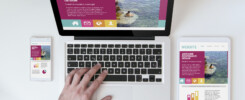- Published:
- Updated: Dec 15, 2023
- 4 Minutes Read
What is the UX Design Process?
Written By:
Author
Did you know, Don Norman first coined the term UX Design in 1995, when he was the vice president of Apple’s Advanced Technology Group.
His intention was to create a term that covered every aspect of a person’s experience with using a system. This included the graphics, any physical interactions, the interface, and even the manual.
These days, the term UX design has evolved into something that enhances Norman’s first iteration. But, with this evolution, comes more confusion in understanding what actually goes into the UX design process.
We’re here to demystify the process for you. Keep reading to get all the ins and out of UX design and why it is more relevant than ever.
What Is UX Design?
At its core, UX design is all about user experience and making that experience the best it can be. In fact, UX stands for user experience.
Its primary aim is to draw people in, making their journey from the homepage to purchase pages enjoyable and seamless.
Why Is UX Design Necessary?
When we consider the benefits of UX design, we can contemplate two factors.
UX design improves the user experience of a product and a good user experience increases the acquisition chance of that product.
In order to achieve these two fundamental goals, we need to understand the goals of our customers, as well as how they intend to use the product. Second, we need to use that understanding to build a product, app, or service to suit their needs.
We need excellent UX design because it generates happy customers, which means more sales.
Understanding the UX Design Process
So we know UX is all about improving a user’s experience, and the easier a product is to use, the better that experience will be. However, before we can get into the ease of use, we need to know what the product is trying to solve.
Any good product or service solves a customer’s problem. This is often where a UX designer is doing most of their work.
They need to figure out what the users actually need, and we do this through a simple four-step process.
The Four Fundamentals
Alright, so we say simple, but it can get pretty complicated. For now, let’s just stick to these four fundamentals. The complexity comes into how you break down each section.
Ultimately though, these four factors make up the pillars of UX design and are going to determine the strength of the product.
User Research
User research should be the starting point for every UX designer. Research will teach us about how the user’s behaviors, their goals, and motivations, as well as their needs.
User research also shows us how a user currently navigates the system. This will highlight any obstacles they may encounter and how they feel when interacting with the product. This is arguably the most important part!
What you think will work brilliantly might fall short for your users. Therefore conducting research on real and diverse individuals is going to be the key to your success.
Remember, your job is to understand why they are behaving a certain way, not to judge or influence their behavior somehow.
Wireframing and Prototyping
A wireframe gives you something tangible to test with real users, which is vital to any design process. The design of your product must revolve around functionality and usability, rather than creative flair. That’s the role of a visual designer at a later point.
Remember, the goal with UX is to solve problems. If you’re not solving someone’s problem, they will not care how visually appealing your product looks.
User Testing
UX designers absolutely need testing stages, as it gives them the room to improve on their original concept and design. There will inherently be flaws and issues that create user difficulties.
That doesn’t make you a bad designer, it just means you’re not a magician, unfortunately, and can’t predict the unforeseen! User research will help you with this, but user testing is where you really bring it home.
Implementation
The role of the UX designer can vary significantly from job to job. In a start-up, a UX designer must have the necessary knowledge and UX certification, as he will be responsible for every phase of the process. This means they’re taking on the research, testing, and design all on their own.
In a larger company, a UX designer may take a more managerial role, heading up a group of researchers and overseeing the testing and design.
At this phase, it’s all going to depend on where your skills and interests lie. Do you prefer a hands-on approach, or do you want to help others realize a shared vision?
What’s the Difference Between UX Design and Web Design?
The two can be fairly interchangeable in the modern age of design. That being said, we need to break down the individual roles to truly get an understanding of where they differentiate.
A web designer may be responsible for the user interface design, front-end coding of the site, UX design, and SEO. What they’re actually responsible for on a day-to-day largely depends on the client.
However, web-designs and UX designers both need to factor in the user’s journey through their product. They both need to consider how their designs will impact the user and their emotions. Everyone can benefit from having a web designer working with them.
It’s All in the Code
We consider web design a ‘multidisciplinary’ field. On top of visual design and user research, web designers are often tasked with coding the products. They would use languages like HTML, CSS, and JavaScript to do this. It is rarely necessary for a UX designer to know how to code.
The key differences, however, lie in the fact that web design is dependent on the platform, while UX design isn’t. That means that UX designs move beyond browsers, apps, and software. It can apply to anything from retail experiences to game navigation.
Web design is also more focused on the tech, while UX design focuses on people. That being said, the way they each work with their respective interfaces is where the secrets to their success really lie.
More Than an Interface
We have always taken a results-orientated approach to design, and we know the importance of a hard-hitting, creative product.
We take our UX design process seriously and aim to offer only the best website designs for you.
Contact us today to see what we can do for you. Your business deserves the best.







This is very informative ty for the blog!